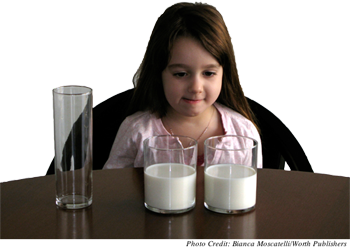

Chapter 1. Child Soldiers and Child Peacemakers
Synopsis
Child Soldiers and Child Peacemakers
Author
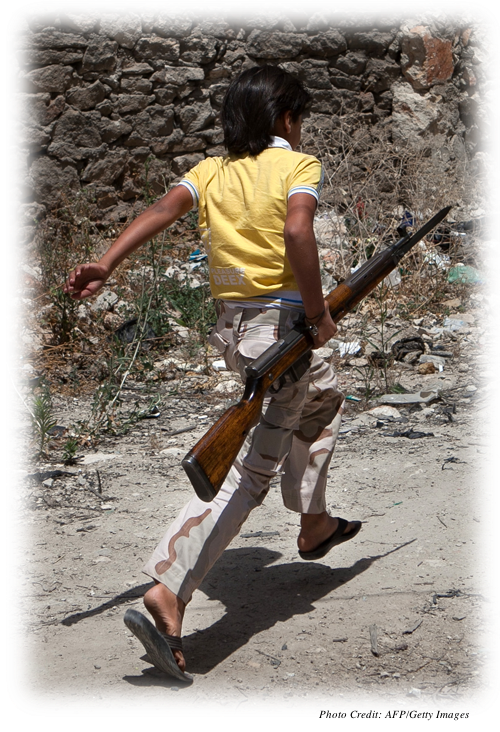
Pauline Davey Zeece, University of Nebraska – Lincoln
Synopsis
This activity focuses on children as soldiers and peacemakers. After briefly examining the state of child soldiers in the world and in Colombia, you will learn of the history of the Children’s Mandate for Peace and Rights. With the help of video, you will discover how developmental components of adolescent cognition are related to the decisions made by five courageous teenage peace activists.
REFERENCES
Child Soldiers Global Report 2004. Retrieved May 12, 2007, from http://www.child-soldiers.org/library/global-reports
Human Rights Watch. Children’s Rights. Retrieved May 12, 2007, from http://hrw.org/compaigns/crp/index.htm
Raymond, A., & Raymond, S. (2000). Children in war. New York: Simon & Schuster Adult Publishing Group.
Child Soldiers
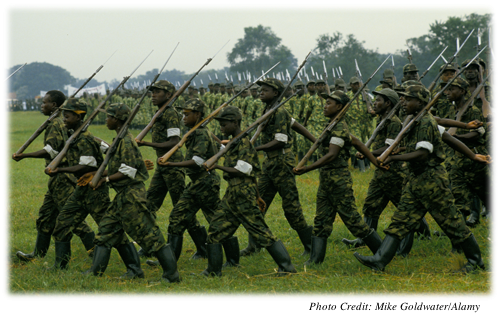
Millions of children worldwide have never known a day of peace. There have been more than 150 wars fought since World War II. In 2000, there were approximately thirty conflicts in different parts of the world (Raymond & Raymond, 2000), and every new year brings potential for new conflicts to arise. If they survive, children of war are often left orphaned, separated from family, homeless, abandoned, and physically and psychologically injured in horrific ways.
Children of war are also soldiers. Since 2001, the participation of child soldiers has been reported in 21 ongoing or recent armed conflicts in almost every region of the globe. Although there are no exact figures, hundreds of thousands of children under the age of 18 serve in government forces or armed rebel groups. Some are as young as eight years of age (Human Rights Watch, 2007).
Children, War, and Development

Coupled with the rapid social changes that often precede or accompany war, armed conflict leads to a breakdown in the very family functions that are so essential to a child’s survival and development. Children need their families to provide them with food, clothing, and shelter, to encourage them to learn, to develop their self-esteem, to nurture their friendships with peers, and to provide harmony and stability at home. These things are not available to child soldiers.
When a conflict subsides, the process of reintegration begins as many children need help establishing new foundations in life or reclaiming their broken homes and lives. These children are often desensitized to suffering, and they are more likely to commit violent acts. The scars of conflict-related child maltreatment, child neglect, and child abuse often seriously complicate a child’s re-establishment of contact with family and community.
Play the video to see some effects of war on children. In this clip, you will hear Reverend Desmond Tutu of South Africa, winner of the 1984 Nobel Peace Prize, along with members of the Children’s Peace Movement of Colombia.
1.
According to the video, how do children become participants in war? What is the effect of war on the lives of children?
Colombia’s Youngest Warriors
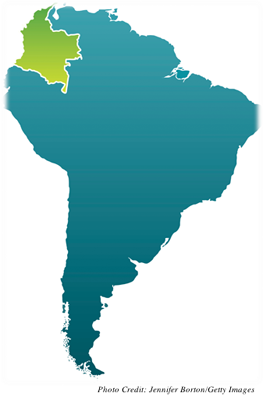
Decades of drug trafficking and guerilla warfare have made Colombia one of the most violent countries in the world. In Colombia today, as many as 14,000 male and female children are used to fight in the 40-year-old conflict among government forces and allied paramilitaries against the armed groups that oppose them (Child Soldiers Global Report, 2004). Guerillas name their child combatants “little bees” because the children sting the enemy without warning. Paramilitaries label them “little bells” because child soldiers are often deployed in forward positions to disarm or discover land mines, to warn adults of an early attack, or to draw fire from an enemy (Human Rights Watch, 2007).
Some children are forcibly recruited, sometimes in large numbers, while others enlist voluntarily as a means of survival after family, social, and economic structures have collapsed. Many join because of poverty, unemployment, lack of access to education, or as an escape from domestic violence, abuse, or exploitation. In 2004, the Colombian military is reported to have used children as young as five years of age as informants. In programs such as “Soldier For a Day,” youngsters visit a local military base where they can dress up and play soldier while being fed pro-military propaganda.
Child Soldiers for Peace in Colombia

For four generations, the families of five Colombian teenage peace activists were caught in the midst of a seemingly unsolvable power struggle between government forces, leftist guerillas, paramilitary death squads, and wealthy drug lords. At great personal risk, these adolescents began grassroots efforts in their hometowns to take a stand against violence and to successfully establish the Children’s Peace Movement.
On October 25, 1996, 2.7 million Colombian children, ages 7 to 18, voted overwhelmingly for the right to life, the right to peace, and the right to family. This special election launched the Children’s Mandate for Peace and Rights. Many feared that there would be violence on the day of the vote, so an extensive media campaign was launched asking all armed groups to respect the vote. Even though cities where the voting took place were in some of the most violent regions of Colombia, there was peace on Election Day. Notably, as a result of their efforts, these five resilient teenagers from Colombia were chosen by UNICEF to go to The Hague in the Netherlands. They attended the historic 1999 International Peace Conference and were nominated twice for the Nobel Peace Prize.
Play the video to learn about the Children’s Peace Movement in Colombia.
Thinking About and Acting for Peace

Clearly, the teenage leaders of the Children’s Crusade for Peace are extraordinary. Developmentally predictable changes in thinking may have aided them as they undertook their journey. One of the most prominent aspects of adolescent thought is the capacity to think of possibility rather than simply reality. This is known as hypothetical-deductive thought. Some teenagers are able to imagine how things “could be, would be, or should be in a world where justice is realized and the sanctity of human life is recognized” (Berger, 2005).
Play the video to learn about the personal experiences of some leaders in the Children’s Crusade for Peace.
2.
Refer back to the video on the previous screen and consider the reasons why these Colombian teenagers began the special election that encouraged children country-wide to vote for peace. Do you see evidence of hypothetical-deductive thought in the video from this screen and/or the video from the previous screen? Please support your answer with specific examples.
A Child Soldier for Peace Speaks
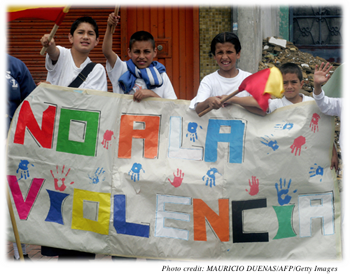
To conclude this activity, refer to the powerful words of Farlis Calle Guerrero, age 18, the founder of the Children’s Peace Movement. She spoke at The Hague Appeal for Peace Conference, on May 11, 1999.
We request to all the adults of all the countries of the world:
Peace in the world,
Peace in our countries,
Peace in our homes,
Peace in our hearts.
Assessment: Check Your Understanding

3.
1. Which of the following groups may be responsible for recruiting child soldiers or informants in Colombia?
Assessment: Check Your Understanding

4.
2. Child soldiers in Colombia rarely experience child maltreatment because of their intrinsic value to the military forces.
Assessment: Check Your Understanding

5.
3. The teenagers who co-founded the Children’s Mandate for Peace displayed significant developmental resilience.
Congratulations! You have completed this activity.Total Score: x out of x points (x%) You have received a provisional score for your essay answers, which have been submitted to your instructor.